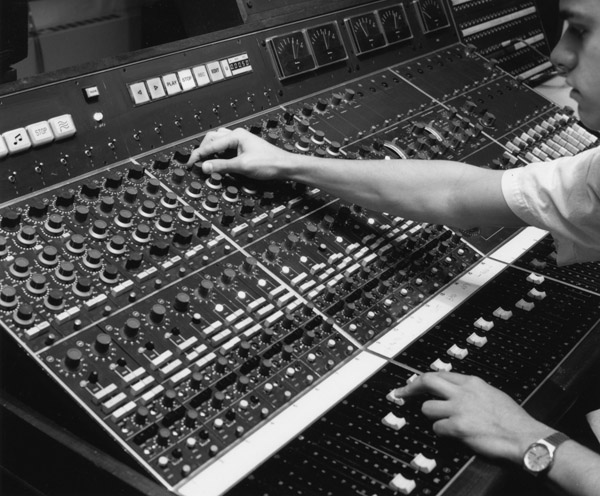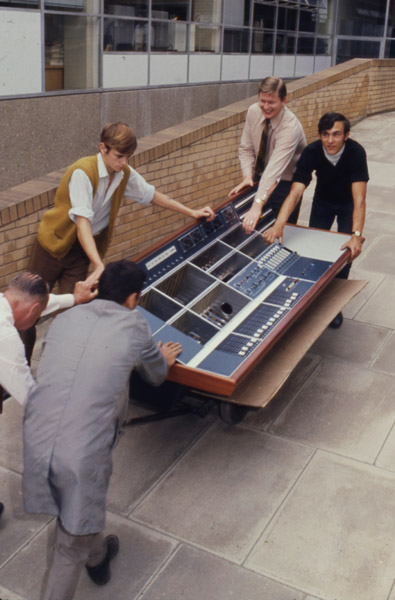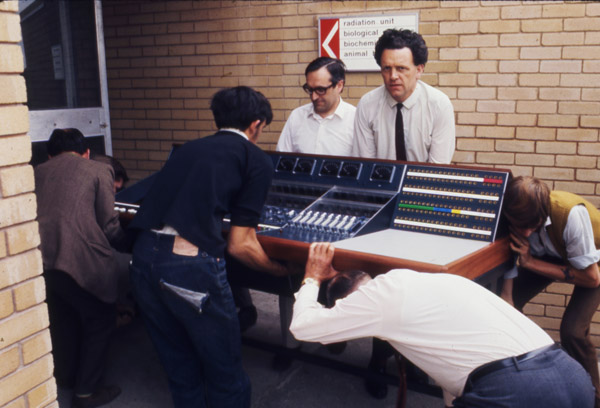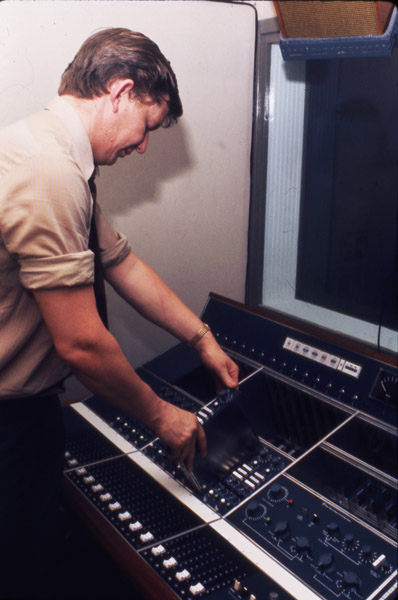IoSR Blog : 5 June 2014
Throwback Thursday: Neve installation
One of the special things about the Tonmeister course at Surrey is its long history; with a first intake in 1970, this year will be the 41st cohort of graduating Tonmeisters. In honour of this, I've recently been going through the archives. Partly to ensure that we appreciate the long history of the course, partly to see what we've grown from and how things have changed, and partly to embarrass the young and fresh-faced students in photos from long ago. Oh, and of course, partly to have something to post on the blog and Twitter feed.
Neve installation
The first set of photos is from the installation of our first Neve studio console - an 8014. Looking at the photos, I'm guessing that this was in the early 1970s. It was installed originally in the studio in the Hall Undercroft, which entailed carrying it up many stairs. The studio originally featured a 4-track reel-to-reel recorder, which was later replaced by an 8-track.

A later picture of the Neve in use, after it had been expanded to 16 channels (note that the EQ modules in the first 4 channels are different)
There were tie lines from this studio to the adjacent studio floor, which was mostly how the studio was used. There were also tie-lines to the University Hall above, which meant that departmental concerts could be recorded, as well as larger classical sessions. There were Mic A / Mic B toggle switches on each channel to select whether to use the mic input from the studio floor or the main hall - this sometimes caught people out.
The location in the Hall Undercroft was great in terms of being central in the University campus. However, it was a bit more challenging when there were bands playing in the hall above (including an early Led Zeppelin gig) - the isolation wasn't great, and sometimes the bands in the hall used to be picked up beautifully by the EMT plate. On occasion there was also a problem with the toilets in the stairwell above the studio - if a pipe broke the water tended to pour into the studio.
Despite the sometimes damp conditions, the console was reliable and we kept it for many years, moving it to Studio 1 in PATS in the late 1980s when our current studios were built. There were a few modifications made along the way: it was increased from 12 to 16 channels, the relatively simple 8-channel monitoring section was removed, and the machine control buttons were removed, among other things. However, on the whole it gave great service, only being superseded in the early 2000s when we needed something that would more easily interface with Pyramix. By this point, the console was old enough to have gained the "vintage" label, so the sale price was many times the purchase price (we think it was around £6000 new). We sold it to Vale Studios, where it's still in use. You can see a video of the studio owner talking about the console.

Students and staff pushing the console up the ramp on an old trolley

Lifting the console up steps, with one person thinking 'why are you taking a photo and not helping?'

Manoeuvring the console into position in the old Hall Undercroft studio

Fitting the channel strips
Modern equivalent
As way of comparison, there's a video of our most recent console installation below. The technology is very different, but it's still a Neve, and we still seem to install them using a combination of found trolleys and student labour.
Call for pictures
If anyone has any old pictures (or any material you think we'd be interested in) related to the Tonmeister course, we'd be grateful if you could let us have a copy. We'll even promise not too publish them if you think they're too embarrassing, but it would still be good to have them for the archive.
by Russell Mason
